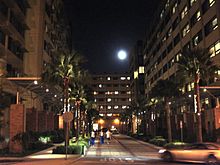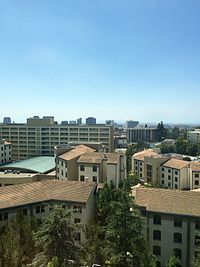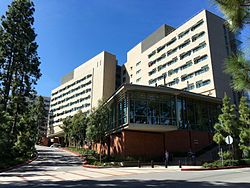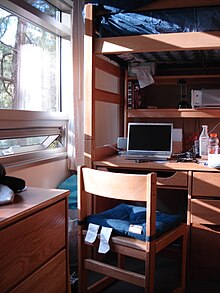Type a search term to find related articles by LIMS subject matter experts gathered from the most trusted and dynamic collaboration tools in the laboratory informatics industry.

Student housing owned by the University of California, Los Angeles is governed by two separate departments: the Office of Residential Life, and Housing and Hospitality Services, and provides housing for both undergraduates and graduate students, on and off-campus.

UCLA's original residence hall was Hershey Hall, located on Hilgard Avenue in South Campus. It was named after Mira Hershey, who bequeathed $300,000 to have the all-women dorm built.[1] The original Hershey Hall of the 1930s is still in use today as an academic building. However, the west wing that was added later was demolished to make way for the Terasaki Life Sciences Building.[2] The men's wing, built in 1959, was located in the current site of Parking Garage 2.[3]
Today, much of UCLA's undergraduate residential community is located on a ridge on the northwestern edge of the campus called "the Hill".[4] The Hill consists of residential complexes housing, dining halls, commons buildings containing student services, conference facilities, and classrooms; facilities for recreational and varsity sports; the Southern Regional Library; and Tom Bradley International Hall, which contains services for foreign students.
Additionally, UCLA owns a number of apartment buildings throughout Westwood known as the University Apartments, some reserved for graduate students but a number reserved for undergraduates.
Student life on the Hill is under the care of the Residential Life (ResLife), formerly called "Office of Residential Life (ORL)". Currently, incoming first-year students are guaranteed four years of on-campus housing and incoming transfer students are guaranteed two years of housing.[5]
Starting in 2009, the Hill underwent the Northwest Campus In-fill Project, which added an additional 1,525 beds, 10 faculty in-residence apartments, a 750-seat dining hall, and four residential towers.[6] Two of these buildings, Holly Ridge and Gardenia Way, which are part of De Neve Plaza, opened February 2012.[7] The other two, Sproul Cove and Sproul Landing, were completed in September 2013. Sproul Cove stands on the previously unoccupied ridge below Rieber Hall. Sproul Landing stands on the former site of the Office of Residential Life, which has relocated to Tom Bradley International Hall.[8]
In 2021, UCLA completed the construction of two additional residence halls on the Hill, Olympic Hall and Centennial Hall, built on an empty ridge between the Saxon and Hitch suites. These new halls provide another 621 rooms and 1,800 new beds for the UCLA undergraduate population, a makerspace and a quick service takeout restaurant.[9]
As of fall 2021, the capacity of the Hill stands at 14,500 students, and UCLA is attempting to guarantee 4 years of housing for freshmen undergraduates and 2 years for transfers by fall 2022.[9]
The Hill is divided into smaller complexes, each organized around a common open space and having its own student services, buffet-style dining halls, and quick-service restaurants, with students permitted to dine at any eatery on the Hill. The following is a listing of the communities, and the buildings located in them:
Named in honor of UCLA's centennial in 2019, it was completed in 2021 and is the newest addition to the Hill's residence halls along with Olympic Hall. Both halls contain deluxe triple and deluxe double style housing.

Named after Felipe de Neve (/dəˈnɛv/ də-NEV), "founder of Los Angeles", De Neve Plaza consists of these buildings:
Front desk services, as well as classrooms and conference facilities, are located in De Neve Commons. Dining options within the complex include the De Neve Residential Restaurant, which is converted nightly to the quick-service options, De Neve Late Night.
Built in 1959, Dykstra (/ˈdaɪkstrə/ DYKE-strə) was the first dorm located on the Hill, as well as the first co-ed residence hall in the United States.[10] The hall is named after UCLA Provost Clarence Dykstra. Though classified as its own separate building, it is considered part of De Neve Plaza for practical purposes, since it is adjacent to the De Neve buildings and physically connected to De Neve Commons (which also happens to be contiguous with Acacia View and Birch Heights). Also, front desk and mailroom services, recreational rooms, and the closest dining options for Dykstra residents are in De Neve Commons. Dykstra reopened for the 2013–2014 school year after a year of renovations.

Named after UCLA Provost Earle Raymond Hedrick (/ˈhɛdrɪk/ HED-rik).
Front desk and mailroom services, as well as recreation facilities, are in the ground floor of Hedrick Hall. The building's own dining option, "The Study at Hedrick", a takeout option connected to a 24-hour study lounge, is adjacent to the ground floor of Hedrick Hall. This building primarily houses 1st year students.
This building consists of nine floors and approximately 900 people. Amenities included within this complex include a TV lounge, recreation room, study lounges and controllable AC for every individual room. Hedrick Summit does not have its own dining option. Hedrick Summit typically houses 1st, 2nd or 3rd year undergraduates or 1st year transfer students.
This all-suite complex consists of four low-rise buildings, lettered A-D. It is classified as an autonomous community, but is considered part of Hedrick Court for practical purposes. Front desk and mailroom services, as well as recreation rooms, are in the ground floor of Hedrick Hall. The closest dining options are located in Rieber Court. After a one-year renovation, Hitch was reopened for the 2014–2015 academic year. Hitch Suites primarily house 1st and 2nd year students along with 1st year transfers.
Named in honor of the 2028 Summer Olympics to be held in Los Angeles for which UCLA will provide athlete housing, this building has 9 stories and aided in accomplishing UCLA's goal of providing 4 years of guaranteed housing to undergraduate students.[11] It was completed in 2021 and is the newest addition to the Hill's residence halls along with Centennial Hall. Includes The Drey as a quick-service food option and has a Makerspace designed to encourage student creation. Rieber Hall acts as both Olympic and Centennial Hall's front desks.
Named after Charles H. Rieber (/ˈriːbər/ REE-bər), first dean of the UCLA College of Letters and Science.
Front desk and mailroom services are on the ground floor of Rieber Hall. Dining facilities within the complex include the Asian cuisine inspired Feast at Rieber adjacent to the ground floor of Rieber Hall and the quick-service option Rendezvous adjacent to the ground floor of Rieber Terrace.
This all-suite complex consists of seven low-rise buildings, lettered E-K. It is classified as a separate community, but is considered part of Rieber Court for practical purposes, since front desk and mailroom services, recreation rooms, and the nearest dining options for Saxon residents are in Rieber Court.


Named after UC President Robert Gordon Sproul (/spraʊl/ SPROWL).
Front desk and mailroom services are in the lobby of Sproul Hall. The complex's main dining facility, Bruin Plate, is located in Carnesale Commons, which opened as Sproul Presidio but was later renamed after former UCLA chancellor Albert Carnesale in October 2013.[8] A quick-service option, Bruin Café, is adjacent to the ground floor of Sproul Hall. Conference facilities are located in the Northwest Campus Auditorium, as well as Carnesale Commons. The complex also contains a gym known as the Bruin Fitness Center (BFit).
Front desk and mailroom services, as well as classrooms and conference facilities, are located in Covel Commons. Dining facilities include the Epicuria, formerly the Covel Commons Residential Restaurant, and quick-service option of Café 1919 adjacent to the ground floor of Delta Terrace. Canyon Point reopened following renovation during the 2013–2014 academic year.[12] Canyon Point and Delta Terrace consist of solely "plaza shared" rooms, wherein two dorms (double or triple dorms) share a bathroom in a 'jack-and-jill' layout. Courtside, on the other hand, consists of only "plaza private" rooms, where 1 dorm (typically a double or triple) has one attached en suite bathroom. All 3 buildings are made up of 8 houses (each housing approximately 50-100 students). These 8 houses are semi-connected (for instance, all 8 houses in Courtside have separate entrances on the ground floor, but are uniformly connected on the second and third floors).
Next to Sunset Village is the Sunset Canyon Recreation Center, the primary sports complex on the hill, containing tennis courts, swimming pools, basketball courts, and volleyball courts for resident use.


There are three different living options for undergraduates, each providing different levels of social interaction, noise level, amenities, and privacy.
There are traditional high-rise Halls, with students grouped by floors, sharing a gender-specific bathroom with 40-50 others. Buildings of this sort include: Dykstra Hall, Hedrick Hall, Rieber Hall, and Sproul Hall. Recently, the Deluxe Residential Hall format has also been introduced, which has some features of the residential plaza, such as more spacious rooms and a thermostat in each room to control air-conditioning. This configuration is found in De Neve Gardenia Way, De Neve Holly Ridge, Sproul Cove, Centennial Hall, Olympic Hall, and Sproul Landing.
The second configuration is the Plaza, which has the same general amenities as the Halls, but has more spacious rooms, and has a private bathroom or shared bathroom with an adjacent room. The twelve plaza buildings include: Hedrick Summit, Rieber Terrace, Rieber Vista, all residential buildings in Sunset Village, and all residential buildings in De Neve Plaza except for Holly and Gardenia.
There are also Suites, which are standalone units supporting 4-6 students, with private bathroom and living space.[4] The complex comprises several buildings sharing a laundry room and outdoor recreational amenities. This configuration is found in Hitch Suites and Saxon Suites.
Each floor or community on The Hill is overseen by one or two Residential Assistants (depending on the community size). These "RAs" are students staff who work to incorporate ResLife's "Core 5" Principles into the living environment. Typically, these RAs host "programs" (events) to encourage residents to meet each other, explore LA and be academically successful. Classic programs include visiting Santa Monica, going to the Ropes Course at Sunset Rec or getting free massages during midterms. These Resident Assistants go through an extensive and competitive interview and training process before getting the position.[13]
In the University Apartments (which are overseen only by Housing and not ResLife), Apartment Coordinators are available to help students.[14]
UCLA also owns and operates 13 apartment complexes around Westwood for upper-division undergraduate students.[15] These include
With the completion of the construction of the most recent apartment complexes, UCLA now guarantees 4 years of undergraduate housing.[16]
Roughly 3,000 graduate students live in one of six UCLA-owned apartment complexes or communities. As of 2007, UCLA housed 26% of its graduate and professional students.[17]
Hilgard House and Weyburn Terrace provide housing for single students. The other graduate units, located south of the 10 Freeway, provide family housing.[18]
The complexes which permit families are zoned to the Los Angeles Unified School District.[26]